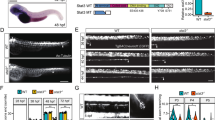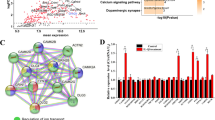Abstract
Spinal cord injury is a devastating health problem that affects thousands of individuals each year. The neurons were destroyed. NT-3 is a recently discovered neurotrophin. This study sought to understand the potential involvement of MAPKs in NT-3-mediated growth inhibition of human neurons. We applied different concentrations of NT-3 and observed the growth rate of the cells and the changes in the phosphorylation state of the MAPKs ERK1/2, JNK and p38. This study discovered that NT-3-induced HNC growth was promoted primarily by phosphorylated ERK1/2, and that this phosphorylation, as well p90rskphosphorylation, was mediated by TrkC. The ERK1/2 pathway is known to play an essential role in the NT-3-mediated growth of human neurons. In conclusion, our study suggests that NT-3 promotes the growth of human neurons cells primarily through the TrkC/ERK pathway.






Similar content being viewed by others
References
Brahimi F, Ko E, Malakhov A, Burgess K, Saragovi HU (2014) Combinatorial assembly of small molecules into bivalent antagonists of TrkC or TrkA receptors. PLoS ONE 9:e89617
Brodski C, Schnurch H, Dechant G (2000) Neurotrophin-3 promotes the cholinergic differentiation of sympathetic neurons. Proc Natl Acad Sci USA 97:9683–9688
Esteban I, Levanti B, Garcia-Suarez O, Germana G, Ciriaco E, Naves FJ, Vega JA (1998) A neuronal subpopulation in the mammalian enteric nervous system expresses TrkA and TrkC neurotrophin receptor-like proteins. Anat Rec 251:360–370
Feron F, Perry C, Cochrane J, Licina P, Nowitzke A, Urquhart S, Geraghty T, Mackay-Sim A (2005) Autologous olfactory ensheathing cell transplantation in human spinal cord injury. Brain 128:2951–2960
Jang JY, Lee SH, Kim M, Ryu JS (2014) Characteristics of neuropathic pain in patients with spinal cord injury. Ann Rehabil Med 38:327–334
Johnson GL (2011) Defining MAPK interactomes. ACS Chem Biol 6:18–20
Jung SY, Kim DY, Yune TY, Shin DH, Baek SB, Kim CJ (2014) Treadmill exercise reduces spinal cord injury-induced apoptosis by activating the PI3K/Akt pathway in rats. Exp Ther Med 7:587–593
Kim HS, Jeong HJ, Kim MO (2014) Changes of functional outcomes according to the degree of completeness of spinal cord injury. Ann Rehabil Med 38:335–341
Lei XF, Kim-Kaneyama JR, Arita-Okubo S, Offermanns S, Itabe H, Miyazaki T, Miyazaki A (2014) Identification of Hic-5 as a novel scaffold for the MKK4/p54 JNK pathway in the development of abdominal aortic aneurysms. J Am Heart Assoc 3:e000747
Moon J, Park SH (2014) Reassembly of JIP1 scaffold complex in JNK MAP kinase pathway using heterologous protein interactions. PLoS ONE 9:e96797
Roloff F, Ziege S, Baumgartner W, Wewetzer K, Bicker G (2013) Schwann cell-free adult canine olfactory ensheathing cell preparations from olfactory bulb and mucosa display differential migratory and neurite growth-promoting properties in vitro. BMC Neurosci 14:141
Tafreshi AP, Zhou XF, Rush RA (1998) Endogenous nerve growth factor and neurotrophin-3 act simultaneously to ensure the survival of postnatal sympathetic neurons in vivo. Neuroscience 83:373–380
Wang LJ, Zhang RP, Li JD (2014) Transplantation of neurotrophin-3-expressing bone mesenchymal stem cells improves recovery in a rat model of spinal cord injury. Acta Neurochir (Wien) 156:1409–1418
Yao YL, Ma J, Wang P, Xue YX, Li Z, Zhao LN, Li ZQ, Feng TD, Liu YH (2014) miR-101 acts as a tumor suppressor by targeting Kruppel-like factor 6 in glioblastoma stem cells. CNS Neurosci Ther 82:1345–1347
Zhong Y, Naito Y, Cope L, Naranjo-Suarez S, Saunders T, Hong SM, Goggins M, Herman JM, Wolfgang CL, Iacobuzio-Donahue CA (2014) Functional p38 MAPK identified by biomarker profiling of pancreatic cancer restrains growth through JNK inhibition and correlates with improved survival. Clin Cancer Res 89:3348–3356
Zhou Q, Gui S, Wang Y (2014) Melatonin Inhibits the Migration of Human Lung Adenocarcinoma A549 Cell Lines Involving JNK/MAPK Pathway. PLoS ONE 9:e101132
Acknowledgments
This work was supported by Grant No. 81450037 from the Chinese National Natural Science Foundation and baiwan project of Inner Mongolia Medical University.
Author information
Authors and Affiliations
Corresponding author
Rights and permissions
About this article
Cite this article
Li, R., Wu, Y. & Jiang, D. NT-3 attenuates the growth of human neuron cells through the ERK pathway. Cytotechnology 68, 659–664 (2016). https://doi.org/10.1007/s10616-014-9813-1
Received:
Accepted:
Published:
Issue Date:
DOI: https://doi.org/10.1007/s10616-014-9813-1




